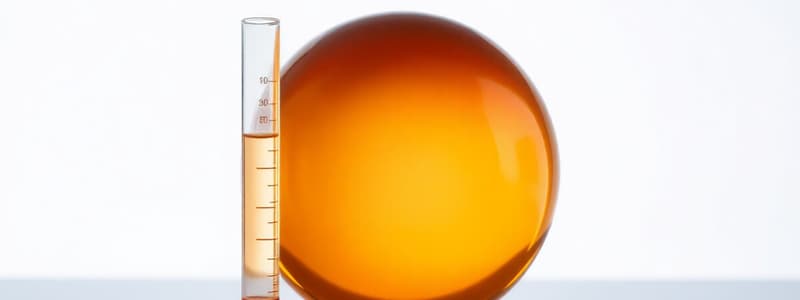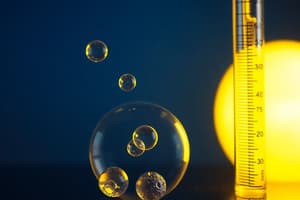Podcast
Questions and Answers
What is the primary characteristic of matter?
What is the primary characteristic of matter?
- It has both volume and mass. (correct)
- It has no mass or volume.
- It is always in a liquid state.
- It can have a fluctuating volume.
How does the volume of gases compare to that of solids when subjected to temperature changes?
How does the volume of gases compare to that of solids when subjected to temperature changes?
- Gases can change volume more easily than solids. (correct)
- Gases change volume less easily than solids.
- Gases and solids have the same volume change characteristics.
- Gases do not change volume with temperature.
What happens to the volume of a gas when it gets cooler?
What happens to the volume of a gas when it gets cooler?
- The gas changes to a liquid state.
- The gas expands significantly.
- The gas's volume typically decreases. (correct)
- The volume usually increases.
Which of the following correctly states the relationship between temperature and the states of matter?
Which of the following correctly states the relationship between temperature and the states of matter?
Which physical property distinguishes gases from solids?
Which physical property distinguishes gases from solids?
What is the primary factor that causes the volume of matter to change?
What is the primary factor that causes the volume of matter to change?
Which state of matter is least affected by changes in temperature when it comes to volume?
Which state of matter is least affected by changes in temperature when it comes to volume?
What characteristic of gases allows them to fill any container they occupy?
What characteristic of gases allows them to fill any container they occupy?
When a gas is cooled, its volume generally will:
When a gas is cooled, its volume generally will:
If two blocks of the same size are made of different materials (e.g., wood and iron), which statement is most accurate regarding their mass?
If two blocks of the same size are made of different materials (e.g., wood and iron), which statement is most accurate regarding their mass?
Which physical property distinguishes solids from the other states of matter?
Which physical property distinguishes solids from the other states of matter?
How does the behavior of gases change when they are subjected to constant pressure during heating?
How does the behavior of gases change when they are subjected to constant pressure during heating?
What is the relationship between volume and temperature in liquids compared to gases?
What is the relationship between volume and temperature in liquids compared to gases?
In terms of volume change, which statement is true regarding cooling gases?
In terms of volume change, which statement is true regarding cooling gases?
What is the term used to describe the three forms that matter can exist in?
What is the term used to describe the three forms that matter can exist in?
Which state of matter is most likely to change its volume with temperature fluctuations?
Which state of matter is most likely to change its volume with temperature fluctuations?
What happens to the volume of a solid when it is heated?
What happens to the volume of a solid when it is heated?
In terms of volume, which statement accurately describes gases at lower temperatures?
In terms of volume, which statement accurately describes gases at lower temperatures?
What characteristic of liquids is similar to that of solids regarding volume change?
What characteristic of liquids is similar to that of solids regarding volume change?
How does air, as a gas, behave when placed in a container?
How does air, as a gas, behave when placed in a container?
What is the primary reason gases are more variable in volume compared to solids?
What is the primary reason gases are more variable in volume compared to solids?
Which of the following correctly describes the effect of cooling on liquids?
Which of the following correctly describes the effect of cooling on liquids?
What happens to the volume of water when it transitions from ice to liquid?
What happens to the volume of water when it transitions from ice to liquid?
Which statement regarding the states of matter is accurate?
Which statement regarding the states of matter is accurate?
What occurs to the volume of a solid when it is heated?
What occurs to the volume of a solid when it is heated?
In what way does the volume change of gases differ from that of solids?
In what way does the volume change of gases differ from that of solids?
Which of these factors primarily affects the volume of matter?
Which of these factors primarily affects the volume of matter?
Considering the properties of matter, which statement is true?
Considering the properties of matter, which statement is true?
What is a common characteristic of gases compared to solids and liquids?
What is a common characteristic of gases compared to solids and liquids?
When comparing the effect of cooling on gases and solids, what can be inferred?
When comparing the effect of cooling on gases and solids, what can be inferred?
Which of the following best describes the behavior of air as a gas?
Which of the following best describes the behavior of air as a gas?
Which statement about the relationship between mass and volume in different states of matter is true?
Which statement about the relationship between mass and volume in different states of matter is true?
Flashcards
What is matter?
What is matter?
Anything that takes up space and has mass.
What is volume?
What is volume?
The amount of space an object occupies.
What are the states of matter?
What are the states of matter?
The three states of matter are solid, liquid, and gas.
What are the characteristics of solids?
What are the characteristics of solids?
Signup and view all the flashcards
What are the characteristics of liquids?
What are the characteristics of liquids?
Signup and view all the flashcards
What are the characteristics of gases?
What are the characteristics of gases?
Signup and view all the flashcards
How does temperature affect matter?
How does temperature affect matter?
Signup and view all the flashcards
What happens to the volume of matter when it is heated?
What happens to the volume of matter when it is heated?
Signup and view all the flashcards
What happens to the volume of matter when it is cooled?
What happens to the volume of matter when it is cooled?
Signup and view all the flashcards
Which state of matter is most affected by temperature change?
Which state of matter is most affected by temperature change?
Signup and view all the flashcards
What happens to a gas when heated under constant pressure?
What happens to a gas when heated under constant pressure?
Signup and view all the flashcards
What happens to the volume of a gas when it is cooled?
What happens to the volume of a gas when it is cooled?
Signup and view all the flashcards
In what states of matter can water exist?
In what states of matter can water exist?
Signup and view all the flashcards
What is mass?
What is mass?
Signup and view all the flashcards
Can objects have the same volume but different masses?
Can objects have the same volume but different masses?
Signup and view all the flashcards
What is inertia?
What is inertia?
Signup and view all the flashcards
How is mass related to inertia?
How is mass related to inertia?
Signup and view all the flashcards
How does mass affect an object's movement?
How does mass affect an object's movement?
Signup and view all the flashcards
What is the definition of matter?
What is the definition of matter?
Signup and view all the flashcards
Do all states of matter have volume?
Do all states of matter have volume?
Signup and view all the flashcards
What are the three main states of matter?
What are the three main states of matter?
Signup and view all the flashcards
How does temperature affect the volume of matter?
How does temperature affect the volume of matter?
Signup and view all the flashcards
What happens to the volume of matter when it is heated?
What happens to the volume of matter when it is heated?
Signup and view all the flashcards
What happens to the volume of matter when it is cooled?
What happens to the volume of matter when it is cooled?
Signup and view all the flashcards
Which state of matter is most susceptible to temperature change?
Which state of matter is most susceptible to temperature change?
Signup and view all the flashcards
What happens to a gas when heated under constant pressure?
What happens to a gas when heated under constant pressure?
Signup and view all the flashcards
What happens to the volume of a gas when it is cooled?
What happens to the volume of a gas when it is cooled?
Signup and view all the flashcards
What are the three states of water?
What are the three states of water?
Signup and view all the flashcards
What is mass?
What is mass?
Signup and view all the flashcards
How is mass related to inertia?
How is mass related to inertia?
Signup and view all the flashcards
What is inertia?
What is inertia?
Signup and view all the flashcards
Study Notes
Matter
- Anything that has volume and mass is considered matter.
- Volume refers to the amount of space an object occupies.
States of Matter
- Matter exists in three states: solid, liquid, and gas.
Temperature and Volume
- The volume of matter can change with temperature.
- Heating matter generally increases its volume.
- Cooling matter generally decreases its volume.
- Gases are more easily affected by temperature changes than solids.
- Gases expand when heated, filling the container they are in.
Examples of States of Matter
- Solids: tables, chairs, desks, windows, walls, floors.
- Liquids: water, juice.
- Gases: air.
Mass and Inertia
- Mass is a measure of how much matter an object contains.
- Inertia is the tendency of an object to resist changes in motion.
- A heavier object (greater mass) will be harder to move and will resist changes in motion more strongly.
Matter
- Matter is anything that takes up space and has mass.
- Matter exists in three states: solid, liquid, and gas.
Volume
- Volume refers to the amount of space something occupies.
- Solids, liquids, and gases all have volume.
- Air, although invisible, is composed of gases and has volume.
Temperature and Volume
- The volume of matter changes with temperature.
- Heating a solid, liquid, or gas generally increases its volume.
- Cooling a solid, liquid, or gas generally decreases its volume.
- Gases are more susceptible to volume changes than solids.
- Gases expand when heated under constant pressure.
- The cooler a gas, the smaller its volume tends to be.
- Water can exist in all three states of matter: ice (solid), water (liquid), and steam (gas).
Mass
- Mass is a measure of the amount of matter in an object.
- Objects with different materials can have the same volume but different masses (e.g., a block of wood and a block of iron).
- Mass influences inertia, the tendency of an object to resist changes in motion.
Matter
- Matter is anything that has volume and mass.
- Volume refers to the amount of space something takes up.
- Solids, liquids, and gases all have volume.
States of Matter
- Matter can exist in three states: solid, liquid, and gas.
- These states are also known as the states of matter.
Temperature and Volume
- The volume of matter can change with temperature.
- Heating generally increases the volume of a solid, liquid, or gas.
- Cooling generally decreases the volume.
- Gases are more easily affected by temperature changes than solids, expanding to fill the container they are in.
- Gases typically expand when heated under constant pressure.
- Cooler temperatures usually result in smaller gas volumes.
Water States
- Water can exist in all three states: solid (ice), liquid (water), and gas (water vapor).
Mass and Inertia
- Mass is a measure of the amount of matter in an object.
- Objects with greater mass have more inertia.
- Inertia is the tendency of an object to resist changes in its motion.
- A heavier object (like a block of iron) will be harder to move than a lighter object (like a block of wood) of the same size.
Studying That Suits You
Use AI to generate personalized quizzes and flashcards to suit your learning preferences.




